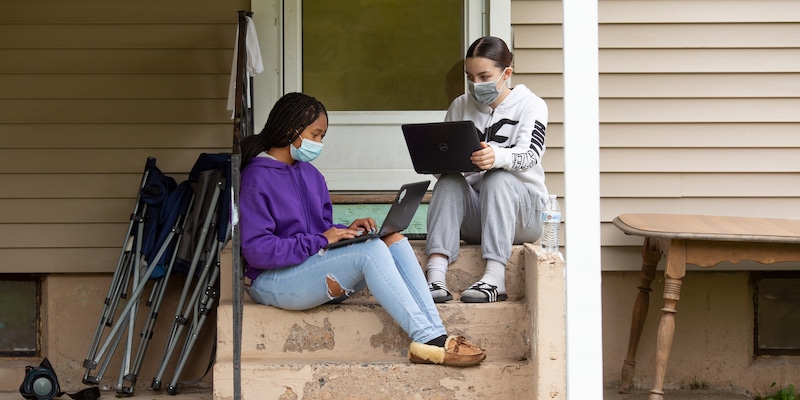During COVID, essential ingredients for learning are in short supply. Many factors are driving a decrease in undergraduate enrollments this year, but community college students in particular report suffering from limited access to their professors for academic support. In K–12, the missing supports may be more dire: 5.5 million children haven’t had contact with their teacher in a week, and many districts are experiencing full-time and substitute teacher shortages.
I’ve argued in the past that now is the time to lean into student agency by reframing students as assets. Failing to do so may mean ignoring a critical resource for supporting students during a challenging year: their peers.
In that vein, I’ve been studying a range of online tools that set out to unlock peer-to-peer learning. In doing so, I’ve noticed a key difference in their designs—one that, in turn, reveals what problems they must solve in order to get good enough to fill some of the academic support gaps in schools and colleges.
That key difference is the one between tools for peer teaching versus those for peer learning. Here’s how to tell them apart:
Peer teaching tools for exchanging knowledge and expertise
Cynthia is stuck on her math problem set—again. She’s looked up Khan Academy videos, but she can’t find one that addresses her area of confusion. She feels envious of her classmate Imran, whose older brother regularly helps him with math problems, and her friend Thalia, who has a private tutor. Then, she remembers hearing from her cousin about a website designed for students to help other students with homework questions. After submitting her question online, she receives an answer from a student in another country, which helps resolve her confusion.
In his book called Peer Learning in Higher Education, David Boud describes peer teaching as when “advanced students…take on a limited instructional role.” Similarly, peer teaching products are built on the idea that the locus of expertise is found in individual students—one student a whiz in math; another the recipient of the highest grade in her comparative literature course.
For example, Brainly lets students crowdsource homework help by “[tapping] into the brainpower of thousands of experts worldwide”—in the form of other students. Anyone can ask a question or submit an answer, and answers are moderated by students who are vetted by the company. Knack enables students with skills in a particular subject to earn money by tutoring their peers. And a variety of tools function as marketplaces for study notes and resources, often paying students to upload high-quality notes, as Nexus Notes and StudySoup do.
The most notable feature of peer teaching tools is that they create a clear divide between learner (e.g., question-asker) and expert (e.g., question-answerer), even though students can participate in both roles. But a different set of tools challenge that divide by asserting that the process of learning together helps each individual learn better.
Peer learning tools for social learning and reciprocal feedback
This winter, Duante’s class is reading The Diary of Anne Frank, and he felt bored even reading a short description of the book online. But this year, his teacher is using a “social annotation” tool that allows Duante to see his classmates’ comments, questions, and highlights as he reads. One of his classmates commented that Anne’s confinement in the attic is reminiscent of the main character in Colson Whitehead’s The Underground Railroad. Responding to the comment, Duante asks whether the persecution that Jewish people face has anything to do with his experience being Black. The teacher suggests that Duante and his classmate research the topic and lead a class discussion next week.
Compared to peer teaching, Boud argues that peer learning “emphasizes students simultaneously learning and contributing to each other’s learning.” The divide between expert and learner is gone, leaving space for what scholars call “social” or “collaborative learning.”
For example, products like Hypothes.is and Perusall set out to change reading from an isolated activity into a social one, betting on the idea that each reader’s reactions and interpretations can help other readers learn and make connections. Other tools are built to help students stimulate each other’s thinking, like Packback, a discussion forum tool that prompts students to ask deeper questions to stimulate each other’s conversation. Peergrade, Peerceptiv, and PeerStudio are all predicated on the idea that learners benefit from both giving and receiving peer feedback.
Compared to peer teaching products, these tools are built with the idea that the locus of expertise is distributed across a learning community. In doing so, they decline to vet expertise or designate some students as tutors or “answerers.”
How peer-to-peer edtech tools improve
At worst, peer-to-peer learning can be seen as a downgrade from best-in-class teaching. So for peer-to-peer learning tools to improve, it’s critical to know what core problem a product is trying to solve. It’s here that the distinction between peer teaching and peer learning emerges as important.
Since peer teaching tools distinguish between learner and expert in any given moment, what they offer is a solution to a technical problem: a platform to match a student needing help in a specific area to a student with vetted expertise in that area.
On the other hand, peer learning tools make no distinction between students who are learning and students who possess expertise. As a result, something—or someone—must facilitate exchanges between students (ranging from discussion forum threads to peer feedback) that spark what Boud calls “reciprocal” or “mutual” learning. And when it comes down to it, this is far more a pedagogical problem than a technical problem.
The strategies developers are using to tackle these problems are varied—and seeing mixed success. In another post, I’ll dig into the moves companies are making to improve peer-to-peer learning, as well as what educators adopting these tools should expect from them. For now, I welcome your feedback in the comments!



